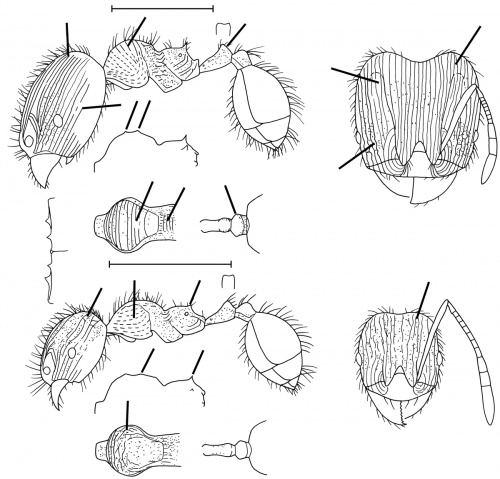Pheidole mittermeieri
| Pheidole mittermeieri | |
|---|---|
| Scientific classification | |
| Kingdom: | Animalia |
| Phylum: | Arthropoda |
| Class: | Insecta |
| Order: | Hymenoptera |
| Family: | Formicidae |
| Subfamily: | Myrmicinae |
| Tribe: | Attini |
| Genus: | Pheidole |
| Species: | P. mittermeieri |
| Binomial name | |
| Pheidole mittermeieri Wilson, 2003 | |
The type series was collected in a savanna, from a termite mound. Winged queens were present in the nest, 2 December. (Wilson 2003)
Identification
See the description in the nomenclature section.
Keys including this Species
Distribution
Only known from the type locality.
Latitudinal Distribution Pattern
Latitudinal Range: -14.8° to -14.80833333°.
| North Temperate |
North Subtropical |
Tropical | South Subtropical |
South Temperate |
- Source: AntMaps
Distribution based on Regional Taxon Lists
Neotropical Region: Bolivia (type locality).
Distribution based on AntMaps
Distribution based on AntWeb specimens
Check data from AntWeb
Countries Occupied
| Number of countries occupied by this species based on AntWiki Regional Taxon Lists. In general, fewer countries occupied indicates a narrower range, while more countries indicates a more widespread species. |

|
Estimated Abundance
| Relative abundance based on number of AntMaps records per species (this species within the purple bar). Fewer records (to the left) indicates a less abundant/encountered species while more records (to the right) indicates more abundant/encountered species. |

|
Biology
Castes
Nomenclature
The following information is derived from Barry Bolton's Online Catalogue of the Ants of the World.
- mittermeieri. Pheidole mittermeieri Wilson, 2003: 459, figs. (s.w.) BOLIVIA.
Unless otherwise noted the text for the remainder of this section is reported from the publication that includes the original description.
Description
DIAGNOSIS Similar in various traits to Pheidole cardiella, Pheidole goeldii, Pheidole nuculiceps and Pheidole striaticeps, differing as follows.
Major: almost all of dorsum of head, most of the sides of head, and almost all the mesosoma covered by carinulae; carinulae on anterior pronotal dorsum curve down and then along the lower pronotal margin; faint antennal scrobes present; in dorsal-oblique view, two denticles present on pronotal profile; in side view, petiolar node tapers to a point; postpetiole from above elliptical.
Minor: most of dorsal and lateral surfaces of head, including occiput variously carinulate and rugulose; anterior third and dorsal margins of promesonotum rugulose to rugoreticulate; propodeal spines reduced to denticles.
MEASUREMENTS (mm) Holotype major: HW 1.14, HL 1.10, SL 0.70, EL 0.14, PW 0.52. Paratype minor: HW 0.60, HL 0.66, SL 0.66, EL 0.08, PW 0.46.
COLOR Major: head, mesosoma, waist, and antennae light brown; gaster and legs dark yellow.
Figure. Upper: holotype, major. Lower: paratype, minor. Scale bars = 1 mm.
Type Material
BOLIVIA: Serena de Huanchaca, Las Gamas, Parque Nacional Noel Kempff Mercado, Santa Cruz, 14°48'S 60°23'W, 700 m, col. Philip S. Ward. Museum of Comparative Zoology
Etymology
ETYMOLOGY Named after Russell A. Mittermeier, distinguished tropical biologist and conservationist.
References
- Wilson, E. O. 2003. Pheidole in the New World: A dominant, hyperdiverse ant genus. Harvard University Press, Cambridge, MA. (page 459, fig. major, minor described)
References based on Global Ant Biodiversity Informatics
- Fernández, F. and S. Sendoya. 2004. Lista de las hormigas neotropicales. Biota Colombiana Volume 5, Number 1.
